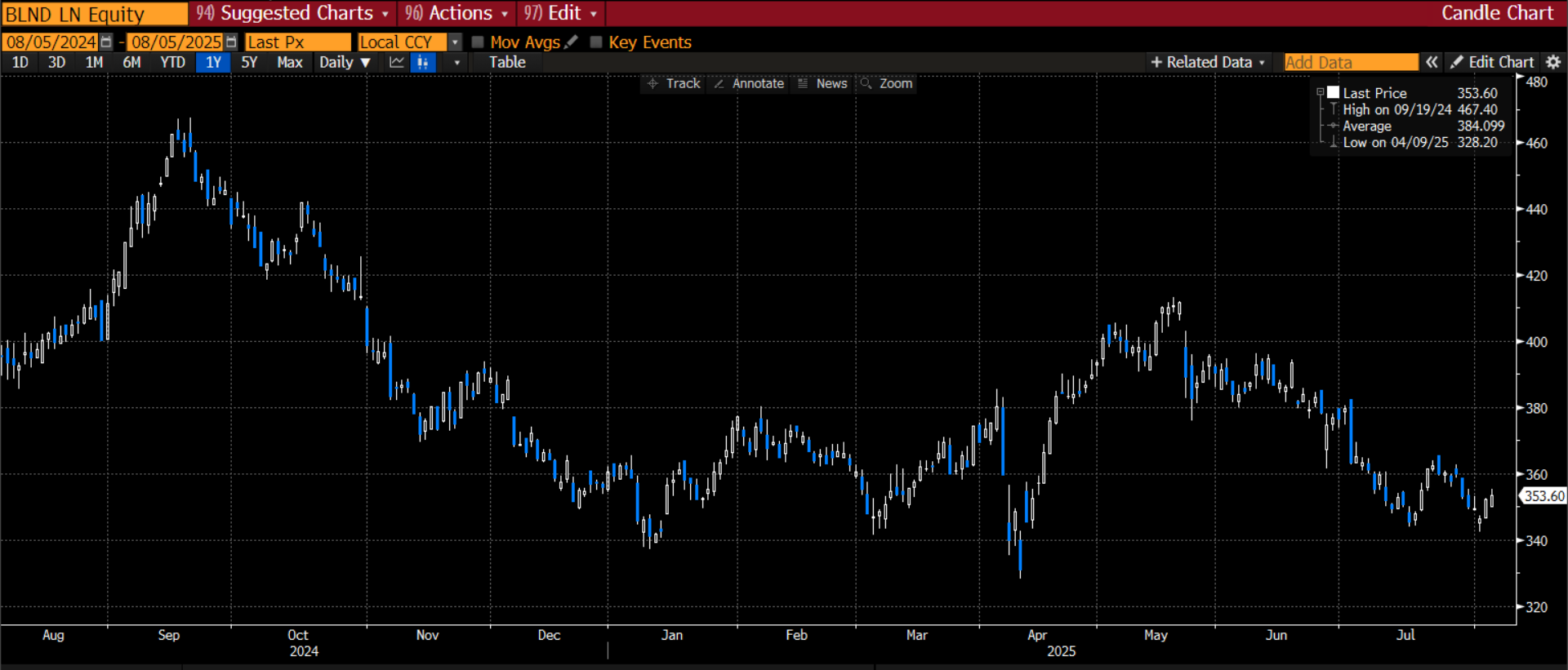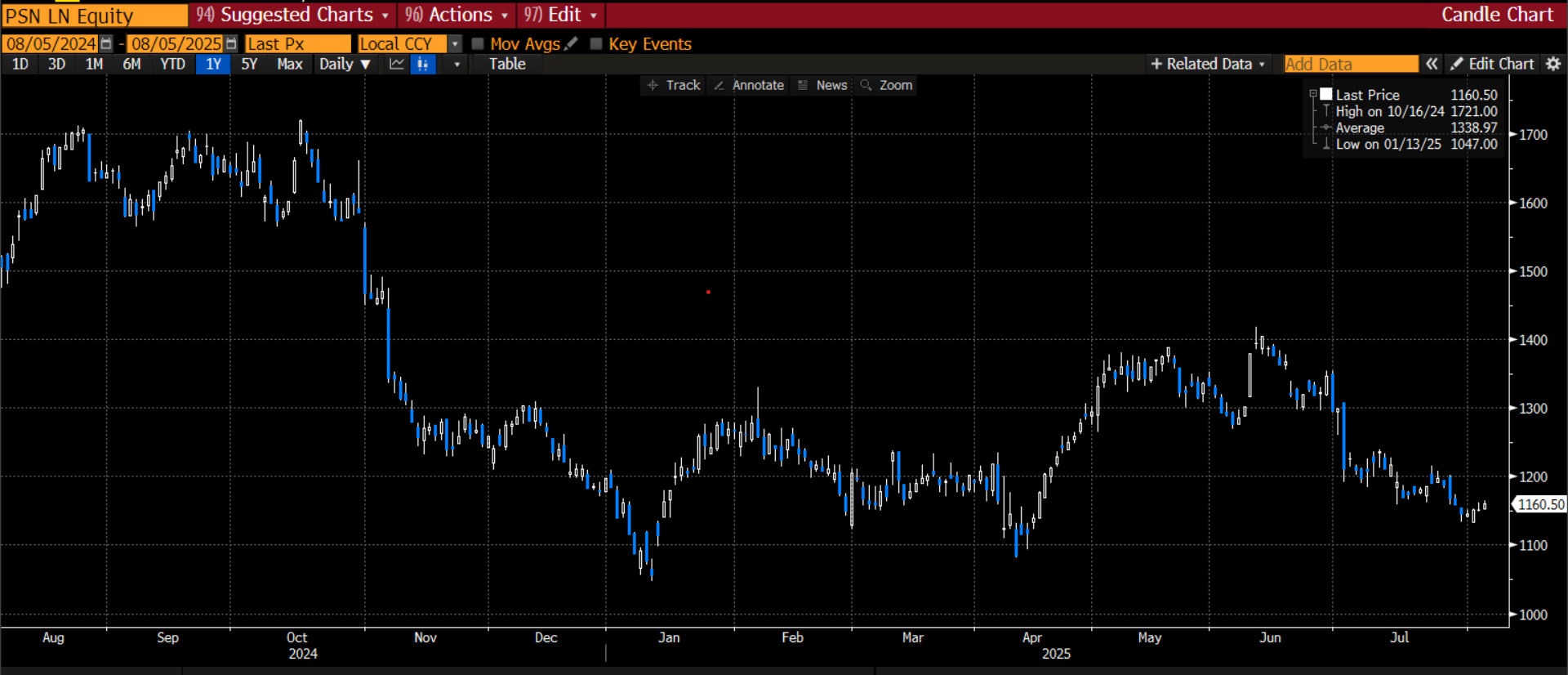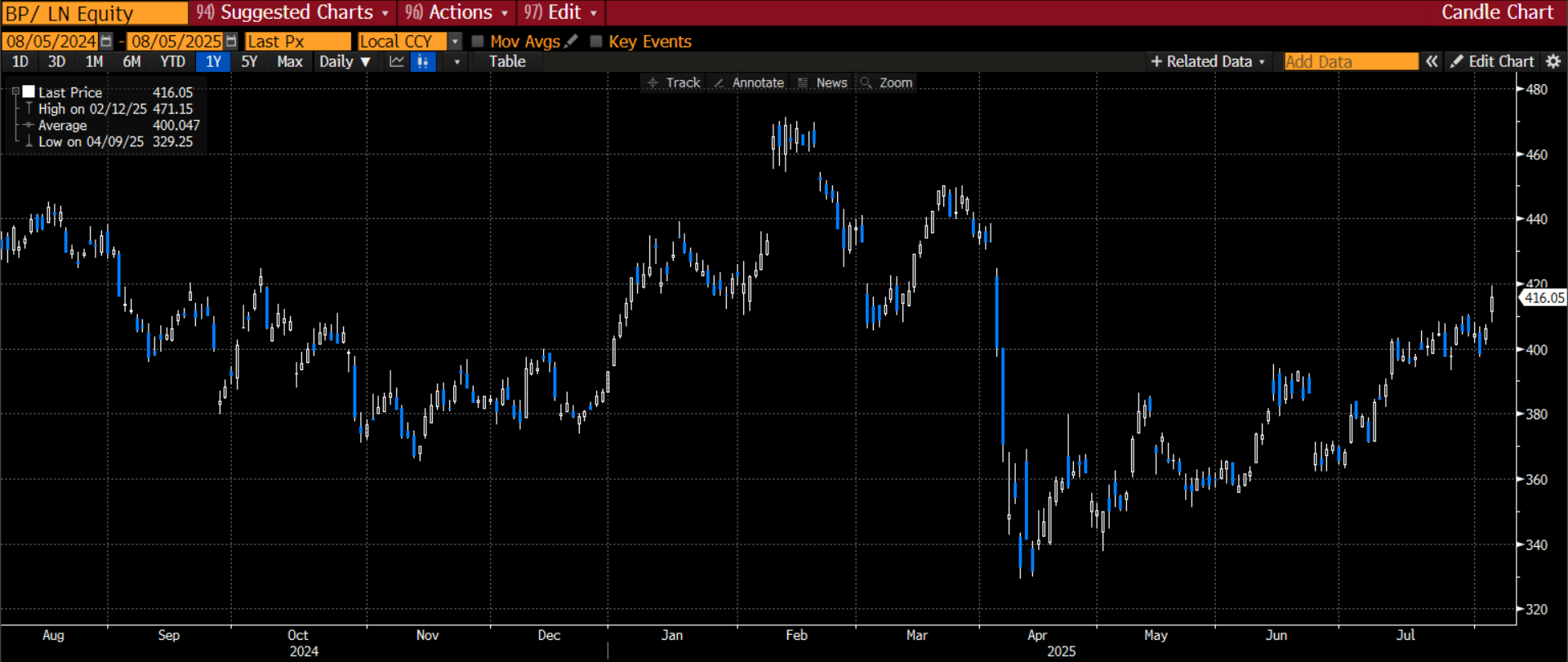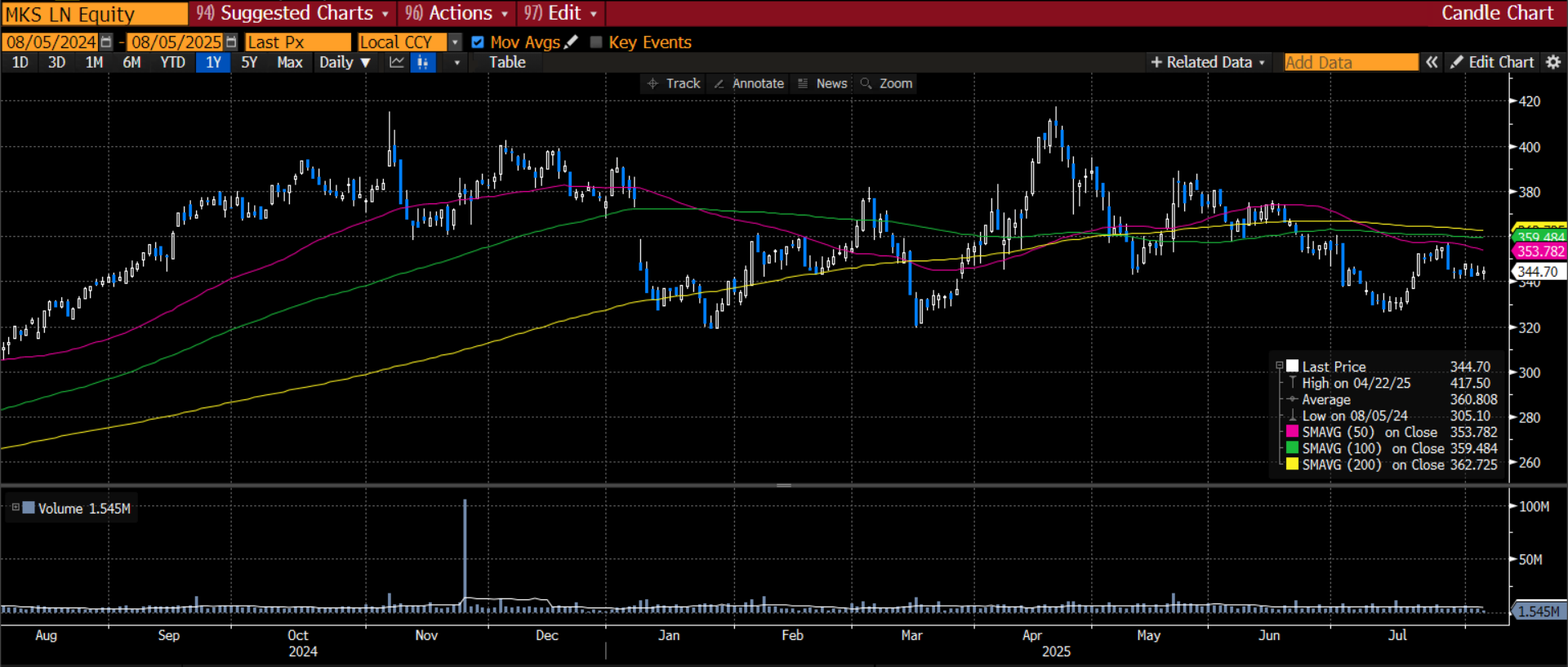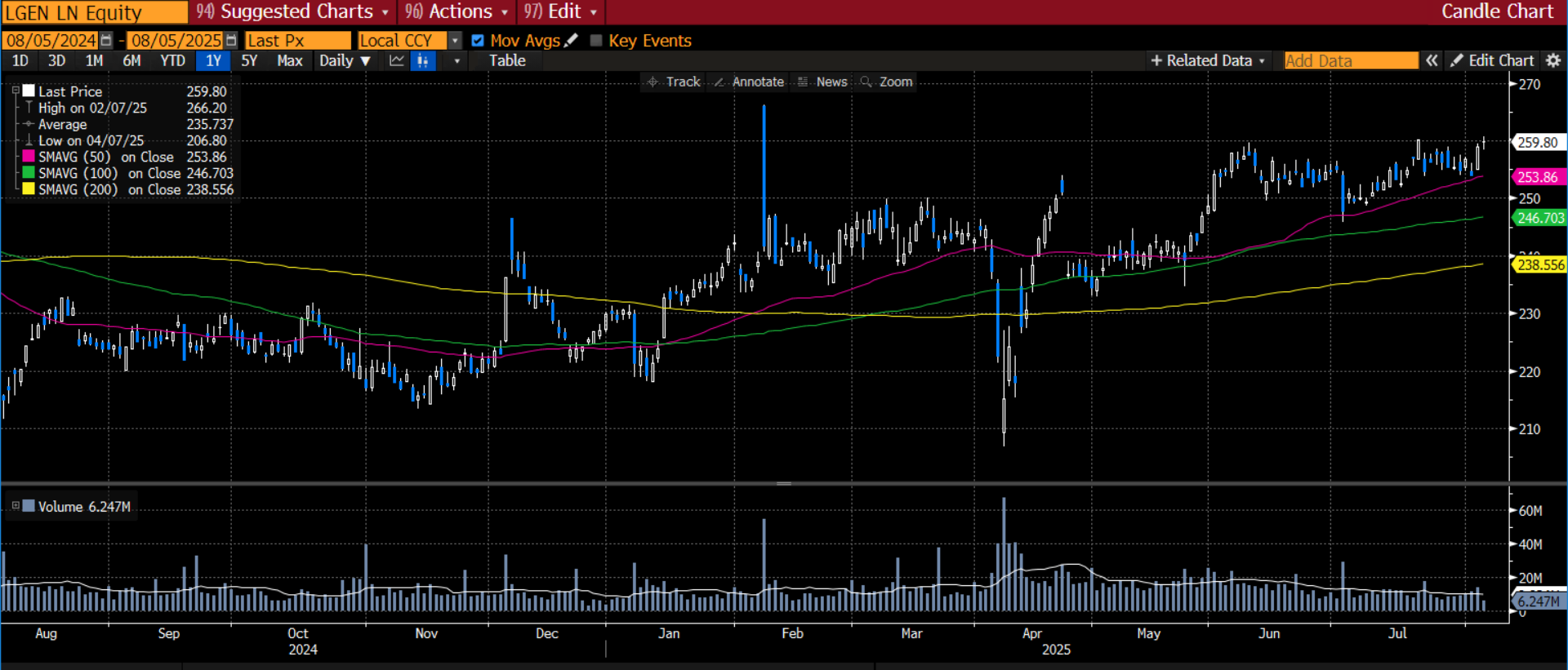1. British Land
This FTSE 250 company could be a key beneficiary of lower interest rates from the Bank of England. If interest rates are cut to 3% over the next 12 months, as the interest rate futures market is predicting, this could benefit the commercial property giant. A stimulative boost from lower monetary policy could help fill the shopping centres and offices that British Land manage. It has been a bruising year for British Land so far, and the share price is down YTD, and is underperforming the overall UK index.
The company has reported a better set of results for the 6 months leading up to the end of March, with rental income and overall revenue coming in ahead of the previous 6 months. Added to this, the valuation looks incredibly attractive, with a 12-month forward P/E ratio of 12.33 times earnings. Combined with expected rate cuts, this stock looks like a steal.
Chart 1: British Land, 12-month price chart
![]()
Source: XTB and Bloomberg. Past performance is not a reliable indicator of future results.
2. Persimmon
The housebuilder has also been in the doldrums so far in 2025, and the share price is down 3% YTD. This is another stock that could benefit from interest rate cuts from the Bank of England. Firstly, capital intensive businesses like house builders will benefit from the lower cost of debt. Secondly, lower interest rates will feed into lower mortgage rates, which could boost demand and house prices, which is good for Persimmon’s bottom line.
Persimmon is also attractive from a valuation perspective and is trading at just over 12 times 12-month forward earnings. Its first half results will be released later in August, and they may show an increase in completions, and progress in acquiring new sites with the potential to boost future volume. Thus, the future could be bright for Persimmon, and its share price may play catch up.
Chart 2: Persimmon, 12-month price chart
![]()
Source: XTB and Bloomberg. Past performance is not a reliable indicator of future results.
3. BP
The UK oil major has been through multiple crises this year, including a rumoured approach by its rival Shell, and dealing with a vocal activist investor. However, its Q2 results may quieten some of the concerns about the company. It posted a $2.4bn profit in Q2, which was stronger than expected. The company plans to reduce costs further and is looking at making further divestments, something activist investor Elliott Management has called for.
BP announced a dividend, and a $750mn share buyback along with its Q2 results in early August. Combined with the better-than-expected earnings data, it appears that BP may have turned a corner and could be looking at a brighter future. Added to the good news, the company announced that it had found its largest oil and gas find in 25 years off the coast of Brazil. This find symbolizes BP’s shift away from green energy and back towards oil and hydrocarbons after dramatically shifting its strategy in 2025.
BP said that oil demand remains robust, and even though the oil price is still below $70 per barrel, if the company can continue to cut costs and focus on its core business, the share price could be in for a prolonged recovery. BP’s share price has underperformed the wider market so far this year and is higher by less than 5% YTD. However, as investors regain confidence in BP, the future looks a lot brighter for the second half of this year.
Chart 3: BP, 12-month price chart, on the way up.
![]()
Source: XTB and Bloomberg. Past performance is not a reliable indicator of future results.
4. M&S
This stock has been in the doldrums since a cyber attack in April levelled the retailer’s thriving online business. The cost of the cyber attack is estimated to be £300mn in lost profits for this year, along with hefty spending to boost the company’s digital security. The online business is back running, although deliveries and returns have not completely returned to normal.
This attack weighed heavily on M&S’s share price, and the FTSE 100 retail stalwart’s share price is lower by more than 8% on a YTD basis. However, M&S did not rest on their laurels. During this period of upheaval, they have gone all in on the business, including upgrading stores, building new stores and extending others. This could pay off handsomely down the road.
M&S could be ripe for a recovery, especially as the FTSE 100’s upward momentum remains strong. If you believe that the outlook for the company is going to improve, then it may be worth looking at M&S’s merits vs. its retail rival Next. Next’s share price has capitalized on the M&S crisis and is higher by 26% YTD, however, it is more richly valued than the overall FTSE 100, and you need to pay up to own Next’s shares. Its 12-month forward P/E ratio is 17 times earnings, vs. 14 times for M&S.
Chart 4: M&S: 12-month chart. This stock looks like it has found a floor and could see a brighter future.
![]()
Source: XTB and Bloomberg. Past performance is not a reliable indicator of future results.
5. Legal and General
When it comes to UK stocks, dividend yields usually come up in the conversation. The UK index has an average dividend yield that is double that of the S&P 500 at 3%, vs. 1.5% for the US blue chip index. This is one area where the FTSE 100 outperforms its US counterpart. The stock with the highest dividend yield on the FTSE 100 is WPP, which has a dividend yield of more than 9%. However, WPP has plenty of its own problems, and part of the reason why its yield is so high is that the stock price and earnings have fallen, yet management have maintained dividends for now.
Instead, we prefer Legal and General. The life insurer has a strong dividend yield of more than 8%. The share price trades at a reasonable 12 times future earnings, and its earnings have tended to beat estimates, as British life insurers tend to be forgotten about by stock analysts.
The stock price is 12% higher so far this year, so it is slightly underperforming the wider market. It is due to report earnings this week, and in the past month, analysts have revised up their expectations for earnings per share, operating profit and net income. Thus, if you are looking for a typically British stock with a plum dividend yield, then Legal & General should be on your horizon.
Chart 5: Legal and General, 12-month chart
![]()
Source: XTB and Bloomberg. Past performance is not a reliable indicator of future results.
This content has been created by XTB S.A. This service is provided by XTB S.A., with its registered office in Warsaw, at Prosta 67, 00-838 Warsaw, Poland, entered in the register of entrepreneurs of the National Court Register (Krajowy Rejestr Sądowy) conducted by District Court for the Capital City of Warsaw, XII Commercial Division of the National Court Register under KRS number 0000217580, REGON number 015803782 and Tax Identification Number (NIP) 527-24-43-955, with the fully paid up share capital in the amount of PLN 5.869.181,75. XTB S.A. conducts brokerage activities on the basis of the license granted by Polish Securities and Exchange Commission on 8th November 2005 No. DDM-M-4021-57-1/2005 and is supervised by Polish Supervision Authority.

